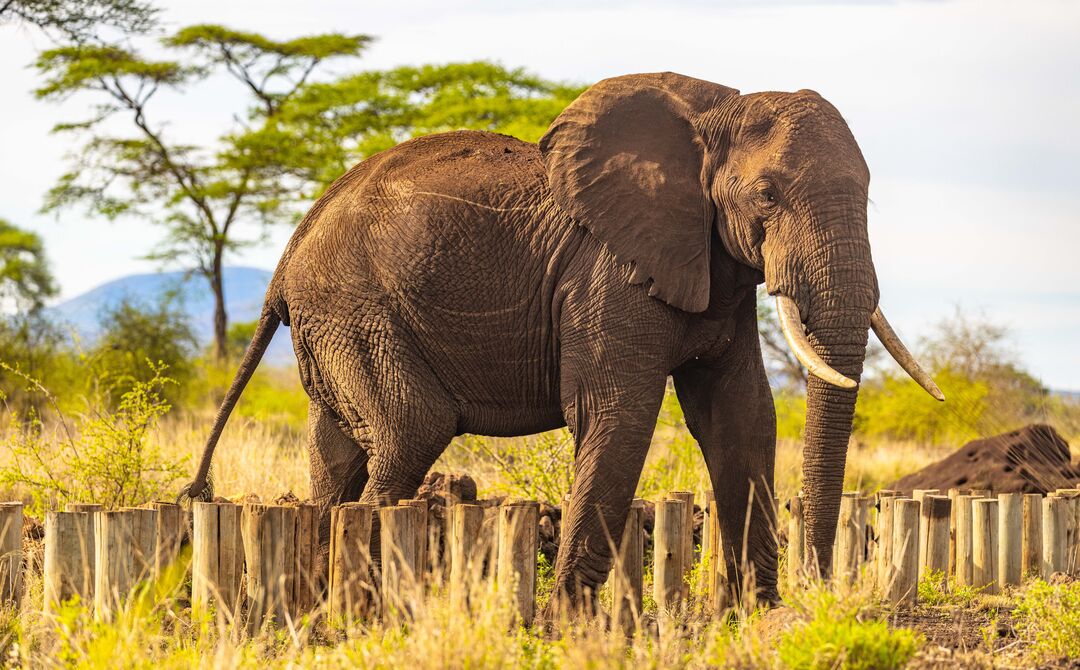People & wildlife in harmony
15 May 2023
PEOPLE & WILDLIFE IN HARMONY
Our Saving Meru’s Giants Manager Newton Simiyu explains why identifying individual elephants and giraffes is a key part of our mission to secure their future.

The conservation of wildlife is an essential part of preserving the natural world for future generations and, funded by supporters, Born Free is committed to promoting tolerance, coexistence, and compassionate conservation among communities around Meru National Park in Kenya.

Saving Meru’s Giants Manager, Newton Simiyu
However, as human populations continue to grow, the pressure on wildlife and their habitats increases. In response to this, we have developed a three-pronged approach that links monitoring elephant and giraffe populations, reducing threats through de-snaring patrols, and promoting compassionate conservation through innovative, practical solutions such as beehive fencing.
Monitoring Meru’s giraffes and elephants is critical for understanding their population dynamics, as well as identifying potential threats to their survival. We use a System for Elephant Ear-pattern Knowledge (SEEK) to identify each elephant and give individual registration codes based on sex, age, and unique features and markings. We currently have 247 identified elephants in our database. In the Meru National Park, this amounts to 75% of the elephant population.
The second step entails reducing threats to wildlife by conducting patrols for de-snaring. Once the populations of elephants and giraffes have been monitored, it is important to assess potential threats and conflicts that may affect their survival. Illegal wire snares are a significant threat to wildlife, particularly to large animals like giraffes. These wire snares, which are frequently used by poachers to capture ‘bushmeat’, are indiscriminate, capable of causing serious wounds, and frequently result in death.
We have a dedicated Twiga Team that conducts regular de-snaring patrols on foot in snare hot spot zones to eliminate wire snares from the habitat to counter this threat. The team has successfully patrolled 560km on foot, removing 677 snares and enhancing the safety of the animals’ habitat.
The third step is promoting compassionate conservation and co-existence via nature-based solutions. One innovative approach to Saving Meru’s Giants project is the use of beehive fencing to help prevent elephants from raiding crops on community farms surrounding the park, which can lead to conflicts.
Born Free places 12 beehives along the perimeter of each crop farms to create a natural barrier that deters elephants from entering. Elephants are known to be afraid of bees and will typically avoid them at all costs. By using beehives as a natural deterrent, farmers can protect their crops without resorting to lethal measures.
In addition to mitigating negative elephant–human interactions, beehive fences contribute to sustainable development by providing supplementary revenue streams. This can lessen the cost of crop damage, thereby raising tolerance and the possibility of long-term and sustainable human-elephant co-existence. Beyond beehive fencing, we have created a conflict toolkit to guide communities on how to use easy-to-implement, low-cost human-elephant conflict resolution techniques.
By linking these three key areas, Born Free creates a comprehensive approach that addresses the key challenges facing wildlife conservation. By monitoring populations, reducing threats, and promoting compassionate conservation, we can protect wildlife and their habitats for future generations. This approach is particularly important in areas with high human-wildlife conflict, where the survival of wildlife populations is under threat. By working with local communities and promoting co-existence, we can find innovative solutions that benefit both wildlife and local people. a collaborative approach can create a future where humans and wildlife can co-exist in harmony, and where the natural world is preserved for generations to come.
You can help by donating to our appeal, End Wildlife Conflict.
